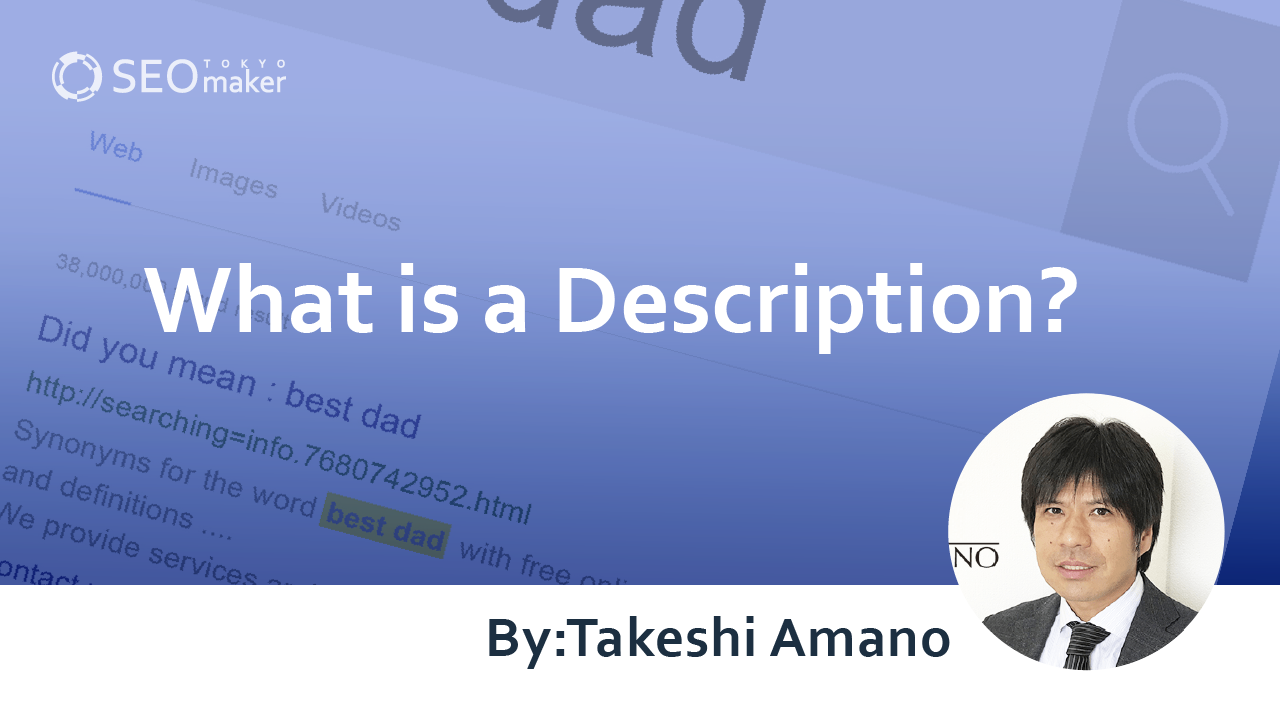What is a Description? Explaining the Meaning, Writing Style, and Changing Word Count
contents
- 1 Internal SEO Measures Overview
- 2 What is Description?
- 3 The SEO Impact of Descriptions
- 4 Optimal Character Count for Descriptions
- 5 Effective Ways to Write Descriptions
- 6 How to Set Up a Description
- 7 How to Check a Description
- 8 Reasons Why a Description Might Not Be Displayed
- 9 When to Review Your Meta Description
- 10 Best Practices for Meta Descriptions
- 11 Frequently Asked Questions about Descriptions
- 11.1 Q: What are other terms for ‘description’?
- 11.2 Q: What is the English notation for ‘description’?
- 11.3 Q: Is there no point in having a description?
- 11.4 Q: What is the optimal number of characters for a description?
- 11.5 Q: Where should the description be written?
- 11.6 Q: Are line breaks reflected in the description?
- 11.7 Q: Does the description impact SEO?
- 11.8 Q: Does the description need to match the page content exactly?
- 11.9 Q: Can the same description be used on multiple pages?
- 11.10 Q: What are the improvement points for a description?
- 12 Summary

A “description” refers to the text displayed on the snippet of a web page in search results. By setting an appropriate description, you can increase the click-through rate to your site on the results page, making it a valuable tool for SEO .
Recently, changes in Google’s search engine updates often lead to modifications in the specifications for snippets and results displays. Therefore, as of 2023, it is crucial to understand the current specifications of snippets including descriptions for effective SEO.
In this article, Tokyo SEO Maker, an SEO-specialized media, will explain descriptions. They provide a clear, beginner-friendly explanation of the meanings and writing styles of descriptions. Moreover, the article includes verification cases to discuss the optimal word count for descriptions in December 2023.
Internal SEO Measures Overview
- Title word count
- Placement of HTML tags
- Setting headings (H tags)
- Configuration of alt attributes
- Optimization of internal links
- Optimization of directory structure
- Implementation of breadcrumbs
- Submission of site maps
- Indexing strategies
- Implementation of structured data
- Adoption of SSL (HTTPS)
- Setting canonical tags
- Unification of ‘www’ presence
- Setting of robots.txt
- URL normalization
- Improvement of page display speed
- Enhancements to UI and UX
- Improvements to Core Web Vitals
- Speed optimization of server processes
- Enhancements for mobile-friendliness
- Introduction to responsive web design
What is Description?
A description succinctly summarizes the content of a web page and is displayed on the snippet found on the search engine results page.
The Difference Between Description and Meta Description
Description and Meta Description are SEO terms used interchangeably. Strictly speaking, the nuances differ slightly; ‘description’ implies functionality displayed in search results, while ‘meta description’ specifically refers to one of the meta tags.
Explaining Meta Description
A meta description is a type of HTML tag written within the meta tags of an HTML document. Meta tags are designed to provide information about web pages to search engines. Thus, a meta description is essentially a specific kind of meta tag.
Related Articles: What is a Meta Tag?
Related Articles: What is HTML?
Explaining Description
The term “description” is a phonetic transcription of the English word ‘description’ and translates to “explanation” or “narration” in Japanese. In the web industry, the term often colloquially refers to what is technically a meta description.
History of Meta Description
Meta descriptions originated in the 1990s with the advent of search engines. Initially known as “meta tags,” they provided search engines with information like page titles, keywords, and meta descriptions.
As search engines evolve, the significance of meta tags diminished, shifting the focus to the content of the pages themselves. However, meta descriptions have retained their importance by summarizing this content.
Today, many websites still set meta descriptions, although search engines have begun generating them automatically since a 2018 algorithm update. Despite this, well-crafted meta descriptions continue to play a critical role in enhancing click-through rates and engaging users.
Reference Page: Yoast
The SEO Impact of Descriptions
Properly setting a description can yield significant SEO benefits.
A description appears in search engine results, providing a summary of the webpage to users. An engaging description can increase the click-through rate (CTR), leading to more traffic from search results. Additionally, when the description matches the page content, it can decrease the bounce rate of site visitors, further enhancing SEO impact.
Related Article: What is Click-Through Rate (CTR) in SEO?
Installation Alone Does Not Produce SEO Effects
As mentioned by Google Search Central, merely setting a description does not directly affect SEO rankings.
“ Even if you use a description meta tag for the snippet displayed, Google’s ranking algorithms do not utilize the description meta tag.
Citation: Google does not use the keyword meta tag in web ranking | Google Search Central Blog | Google for Developers
For example, if your site has a description and a competitor’s site does not, the mere presence of a description will not improve search rankings. The SEO benefits occur indirectly when the description is optimized to meet the needs of search users.
Optimal Character Count for Descriptions
There is no strict limit on the character count for descriptions. However, there is an optimal length.
Generally, the appropriate length for a description is determined by whether it fits within the search result snippet, which is typically between 60 to 120 characters. The variance in character count can be explained by differences in device screens, such as between computers (PCs) and mobile devices. Thus, the number of characters that fit into a snippet can vary depending on the device.
As of December 2023, the character count for descriptions on PC-oriented web pages ranges from 60-85 characters
However, it is said that this appropriate character count can change. Upon investigation, as of December 2023, it has been found that the display character count for descriptions on web pages intended for computers ranges from approximately 60 to 85 characters.
However, there is no official announcement from Google on this matter. The character count may continue to change, so aiming for about 70 characters is a safe bet, especially considering mobile devices.
Research Example 1 for Character Count on PC-Oriented Web Pages
Below is an example from Tokyo SEO Maker, showing the results for an article indexed on our site. In this case, the description for a PC-oriented web page contained 82 characters.
The Displayed Description
SEO stands for Search Engine Optimization. It refers to the process of optimizing a website to increase its visibility in search engine results.
Research Example 2 for Displayed Character Count on PC-Oriented Web Pages
This result comes from another article by Tokyo SEO Maker. In this case, the description displayed consisted of 68 characters.
Explaining the Displayed Description
This article discusses primary information. It also covers the differences between primary and secondary information, and the advantages of handling primary information for general businesses, mass media, and different web media.
Effective Ways to Write Descriptions
To write effective descriptions, consider the following points.
-Prepare a description for each page
-Create a description that matches the page
-Enhance the quality of the text
Prepare a Unique Description for Each Page
It’s essential to create a unique description for each page. As a website grows, reusing the same descriptions can lead to inappropriate text or the production of duplicate content, which is detrimental to SEO.
By preparing a unique description for each page, you can improve the click-through rate (CTR). Conversely, reusing descriptions can lead to irrelevant content for the pages, making them essentially unnecessary.
Create Descriptions That Match Page Content
Ensure that descriptions accurately reflect the content of the page. If the description matches the page content, it reduces the risk of visitors immediately leaving the site. Even if the CTR increases, a high bounce rate can negatively affect SEO. So, care must be taken.
As a specific method, you can create an appropriate description by incorporating main keywords and related keywords that succinctly represent the page. Additionally, depending on the nature of the website, techniques such as posting spec data for products or services explained on the page are also recommended by Google Search Central.
“ For product pages, key information like price, release year, and manufacturer may be scattered throughout the page, but an appropriate meta description should include all this data.
For example, the following meta description contains detailed information about a book, with the information clearly tagged and separated:
<meta name=’description’ content=’Author: AN Author, Illustrator: V. Gogh, Price: $17.99, Pages: 784′>
Citation: Managing Snippets and Meta Descriptions | Google Search Central | Documentation | Google for Developers
Enhance Text Quality
Descriptions should succinctly and clearly convey the content of the web page. Consider what your site needs to communicate and improve the quality of the descriptions accordingly. Also, ensure the text is free from grammatical errors and typos. Descriptions that contain specific information and summarize the entire page are recommended by Google Search Central.
-Description containing specific information
-Description that summarizes the entire page
How to Set Up a Description
To set up a description, it is necessary to implement a meta description as a meta tag within the web page.
Inserting the Meta Description into the Head Tag
Specifically, you should insert the meta description tag inside the head tag of the HTML document.
A web page’s overall structure is composed of HTML, organized like this.
<!DOCTYPE html>
<html>
<head>
*Information not displayed on the web page
</head>
<body>
*Information displayed on the web page
</body>
</html>
The head tag is used to insert elements known as meta tags, which convey information to search engines. Information in the head tag is not visible to users, whereas the body tag governs the visible part of the web page.
Since a meta description is a type of meta tag, you will insert it into the head tag as follows.
<!DOCTYPE html>
<html>
<head>
<meta name= "description "content= "* Insert a description for the description "/>
</head>
<body>
</body>
</html>
This completes the setup of the description.
*Please use half-width quotation marks ” ” in descriptions within the article.
Related Articles: What is HTML?
Related Articles: What is a Meta Tag?
How to Check a Description
To check a description, you should view the source code. Here’s how to do it using Google Chrome.
- Click on the browser menu “View” → “Developer/Manage” → “View Source.”
- Use the page search function and type in “description.”
Following these steps, you can verify the presence of the meta description in the source code of the web page you are viewing.
Reasons Why a Description Might Not Be Displayed
There are several reasons why a description might not appear.
-The meta description is not implemented correctly.
-Google deems the description inappropriate.
-Enough time has not passed for the search engine to reflect the changes in the search results.
(h3 ) Meta Description Is Not Implemented Correctly
If meta description is not implemented correctly, the description will not display in the Snippet.
If the description you set does not appear in the search results, check the source code of the relevant web page. Additionally, you can use Google’s Rich Results Test, an SEO tool, to check if the description is recognized by the search engine.
Tool URL: Rich Results Test
If the meta description is not correctly implemented, the tool will reveal whether the description is detected by the search engine.
If Google Deems the Description Inappropriate
When you set a description, it appears on the snippet. However, it is not guaranteed that the description will always appear as intended on the snippet. Google analyzes the web page and decides the appropriate text to display based on its analysis.
Furthermore, the number of characters displayed in the description can vary by device. If the description length does not match the snippet size, it may be truncated with an ellipsis “…”, so be cautious.
If Sufficient Time Has Not Passed for Search Engine Results to Reflect Updates
It takes some time for updates to a web page to be reflected in search engine results. This timing can depend on various factors such as the website’s ranking priority and the search engine’s operation status.
However, if updates to a page are not reflected in the search results over a long period, it might indicate issues with the website. Consider consulting with in-house engineers to resolve these issues.
When to Review Your Meta Description
There are specific times when you should consider reviewing your meta description.
Here are three times to consider revising your meta description:
-When you make significant changes to the site content
-When changes are automatically made by search engines
-When character limits change due to algorithm updates
When Significant Changes Are Made to the Site Content
If there is a major overhaul of your site, it is crucial to review the meta description settings.
Even if the site’s content is updated to reflect the latest information, an outdated description can decrease user satisfaction and reduce visitor engagement.
Visitors may spend less time on the site if they can’t find the information they want. Consider resetting your meta description when you make significant changes to the content.
When the Search Engine Automatically Changes
Despite setting a meta description yourself, search engines might overwrite it if there is a mismatch between the site content and the summary.
If a search engine automatically creates summary text by extracting content from the site, it will reconsider all meta descriptions.
When Algorithm Updates Affect Character Counts
Even if you set the meta description with specific character limits in mind, updates to Google’s algorithms could change these limits.
Even if you input with a limit of 120 characters for PC and 60-80 characters for mobile, the character count could still decrease further.
If this happens, the carefully crafted text you entered might get cut off and not display, affecting the click-through rate.
If the number of characters displayed changes, reconsider your meta description.
Best Practices for Meta Descriptions
Setting the meta description correctly can communicate accurate information to users and search engines, enhancing brand building and increasing click-through rates. Here are the best cases.
Amazon
On its homepage, Amazon uses a meta description that accurately describes its wide range of categories. Additionally, it includes popular search keywords like “books,” “fashion,” and “food” to enhance its searchability.
Apple
On Apple’s Japanese homepage, the product information is succinctly described. Additionally, to help users properly understand the corporate image, appealing expressions like “confident” are used.
HubSpot
HubSpot, a marketing platform, places a strong emphasis on meta descriptions. By reading the meta description, users can clearly understand what to expect from the page. For example, pages about SEO accurately describe the benefits of using HubSpot’s tools.
Frequently Asked Questions about Descriptions
Here are some common questions about descriptions, formatted as FAQs.
Q: What are other terms for ‘description’?
A: Description is also called a meta description. They are SEO terms used interchangeably, and the former is an abbreviation of the latter.
Q: What is the English notation for ‘description’?
A: Description is noted in English as “description.”
Q: Is there no point in having a description?
A: Descriptions help improve the click-through rate (CTR) of search results.
While setting a description alone does not affect SEO, a properly placed description can increase the likelihood of users visiting your page.
Q: What is the optimal number of characters for a description?
A: Aim for 60-85 characters when creating a description for mobile devices.
Previously, about 120 characters were optimal for desktop web pages. However, as of December 2023, the character count for descriptions on desktop results has been noted to decrease to about 60-85 characters.
It is now appropriate to create descriptions within this range to match mobile device displays.
Q: Where should the description be written?
A: Write it in the head tag of an HTML document.
Specifically insert the following meta tag in the head tag.
<meta name= " description " content= " *Enter the description text here " />
Q: Are line breaks reflected in the description?
A: No, line breaks are not reflected in the description.
Q: Does the description impact SEO?
A: Yes, descriptions help search engines understand the theme of the page. Including appropriate keywords and accurate information can indirectly impact SEO.
Q: Does the description need to match the page content exactly?
A: It is important to write accurate descriptions, but they do not need to be an exact match. It is sufficient if users can understand what information the page provides when they visit.
Q: Can the same description be used on multiple pages?
A: It is not recommended to use the same description across multiple pages. Please write a unique description for each page. Every page on a website should be original, and therefore, the description should also be varied according to the content of each page.
Q: What are the improvement points for a description?
A: To improve a description, the web team must first understand the content of the page accurately. Consider the users’ needs when writing the description and do not forget to include relevant SEO keywords.
Summary
SEO consultants note that descriptions play a crucial role in conveying information about web pages to search engines and users. An optimal description reflected in search results can enhance CTR. Therefore, understanding the specifications of the snippet display and writing the description accordingly is essential. Website operators facing challenges with CTR from search entries should consider reviewing and tweaking their descriptions.










![What is a Description? Explaining the Meaning, Writing Style, and Changing Word Count – [2023 Edition]](https://www.switchitmaker2.com/en/wp-content/uploads/2024/09/what-is-description.webp)










